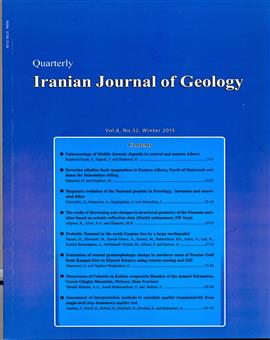Occurrence of Celestite in Kalhur evaporatic Member of the Asmari Formation, Garah Chegha Mountain, Mehran, Ilam Province
Subject Areas :
Keywords: Celestite Strontianite Asmari Formation Kalhur member Ilam.,
Abstract :
The occurrence of celestite in Kalhur evaporitic member of the Asmari Formation in Garah Chegha Mountain, Saleh-Abad, Mehran in the province of Ilam is documented through a field work, thin section petrography, fluid inclusion, X-ray diffractometry and whole rock geochemistry studies. The celestite can only be observed in thin sections of the dark gray colored limestone with fine to medium size grain, dolomitic limestone and dolostone impregnated with bitumen. Polarized light microscopic study shows that celestite occurs mainly as disseminated or an aggregate of crystals and in terms of modal percentage varies from 1 to 15. The crystal shows a variety of textures including replacement, disseminate, aggregates, void filling, fracture and radial-fibrous textures. X-ray fluorescence analyses indicate that the celestite bearing rocks contain 1.65-12.99 wt.% SrO, 31.73-50.52 wt% CaO, 0.27-15.74 wt% MgO and 0.9-10.07 wt% SO3 respectively. Average minor element contents in the studied samples are: 1.2 wt% SiO2, 0.7 wt% Al2O3, 0.2 wt% Fe2O3, and 0.1 wt% Na2O. Normative mineral recalculation shows that the content of celestite in the studied samples varies from 2 to 23 wt% with an average grade of 8 wt%. Strontianite, considered as an alteration product of celestite, is only seen in two specimens, probably resulting from celestite replacing. The most abundant homogenization temperatures of fluid inclusions in celestite crystals fall between 164 and 184 °C and the majority of calculated salinity values are restricted to 8.5 - 9.5 wt% NaCl. Petrographic, mineralogical, fluid inclusion and geochemical analyses indicate that carbonate-hosted celestite is diagenetic in origin implying its formation during the dolomitization and transformation of probably aragonite to calcite and then to dolomite. In contrast, vein and veinlet celestite postdate diagenesis of carbonate rocks and may imply epigenetic origin.

